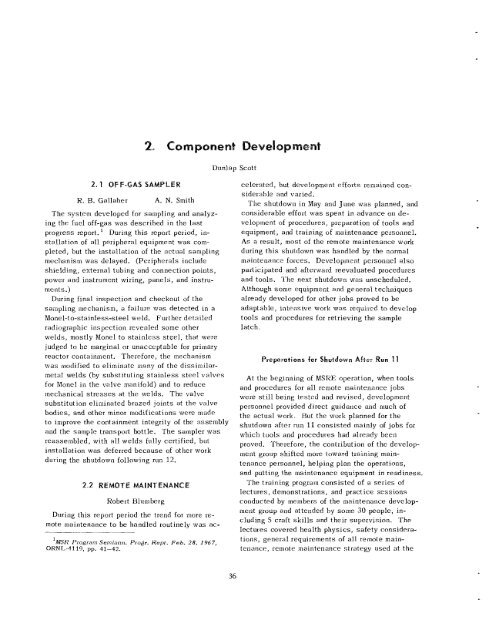ORNL-4191 - the Molten Salt Energy Technologies Web Site
ORNL-4191 - the Molten Salt Energy Technologies Web Site
ORNL-4191 - the Molten Salt Energy Technologies Web Site
You also want an ePaper? Increase the reach of your titles
YUMPU automatically turns print PDFs into web optimized ePapers that Google loves.
R. B. Gallaher A. N. Smith<br />
The system developed for sampling and analyz-<br />
ing <strong>the</strong> fuel off-gas was described in <strong>the</strong> last<br />
progress report. During this report period, in-<br />
stallation of all peripheral equipment was com-<br />
pleted, but <strong>the</strong> installation of <strong>the</strong> actual sampling,<br />
mechanism was delayed. (Peripherals include<br />
shielding, external tubing and connection points,<br />
power and instrument wiring, panels, and instru-<br />
ments.)<br />
During final inspection and checkout of <strong>the</strong><br />
sainpling mechanism, a failure was detected in a<br />
Monel-to-stainless-steel weld. Fur<strong>the</strong>r detailed<br />
radiographic inspection revealed some o<strong>the</strong>r<br />
welds, mostly Monel to stainless steel, that were<br />
judged to be marginal or unacceptable for primary<br />
reactor containment. Therefore, <strong>the</strong> mechanism<br />
was modified to eliminate man.y of <strong>the</strong> dissirnilar-<br />
metal welds (by substituting stainless steel valves<br />
for Monel in <strong>the</strong> valve manifold) and to reduce<br />
mechanical stresses at <strong>the</strong> welds. The valve<br />
substitution eliminated brazed joints at <strong>the</strong> valve<br />
bodies, and o<strong>the</strong>r minor modifications were made<br />
to improve <strong>the</strong> containment integrity of <strong>the</strong> assembly<br />
and <strong>the</strong> sample transport bottle. 'The sampler was<br />
reassembled, with all welds ful.ly certified, but<br />
installation was deferred because of o<strong>the</strong>r work<br />
during <strong>the</strong> shutdown following run 12.<br />
2.2 REMOTE MAINTENANCE<br />
Robert Blimberg<br />
During this report period <strong>the</strong> trend for more re-<br />
mote rnairitenance to be handled routinely was ac-<br />
'MSR Program Semiann. Progr. Hept. Feb. 28, 1967,<br />
OKNL-4 119, pp. 41-42.<br />
Dunlap Scott<br />
36<br />
celerat.ed, hut development efforts remained considerable<br />
and varied.<br />
The shutdown in May and June was planned, and<br />
considerable effort was spent in advance on development<br />
of procedures, preparation of tools and<br />
equipment, and training of maintenance personnel.<br />
As a result, most of <strong>the</strong> remote maintenance work<br />
during this shutdown was handled by <strong>the</strong> normal<br />
maintenance forces. Development personnel also<br />
participated and afterward reevaluated procedures<br />
and tools. The next shutdown was unscheduled.<br />
Although some equipment and general techniques<br />
already developed for o<strong>the</strong>r jobs proved to be<br />
adaptable, intensive work was required to develop<br />
tools and procedures for retrieving <strong>the</strong> sample<br />
1 at c h.<br />
Preparations for Shutdown After Run 11<br />
At <strong>the</strong> beginning of MSKE operation, when tools<br />
and procedures for all remote maintenance jobs<br />
were still being tested and revised, development<br />
personnel provided direct guidance and much of<br />
<strong>the</strong> actual work. Rut <strong>the</strong> work planned for <strong>the</strong><br />
shutdown after run 11 consisted mainly of jobs for<br />
which tools and procedures had already been<br />
proved. Therefore, <strong>the</strong> contribution of <strong>the</strong> developnent<br />
group shifted more toward training maintenance<br />
personnel, helping plan <strong>the</strong> operations,<br />
and putting +.he maintenance equipment in readiness.<br />
The training program consisted of a series of<br />
lectures ~ demonstrations, and practice sessions<br />
conducted by members of <strong>the</strong> maintenance development<br />
group and attended by some 30 people, including<br />
5 craft skills and <strong>the</strong>ir supervision. 'The<br />
lectures covered health physics, safety considerations,<br />
general requirements of all remote maintenance,<br />
remote maintenance strategy used at <strong>the</strong>



![Review of Molten Salt Reactor Physics Calculations [Disc 2]](https://img.yumpu.com/21979492/1/190x247/review-of-molten-salt-reactor-physics-calculations-disc-2.jpg?quality=85)












